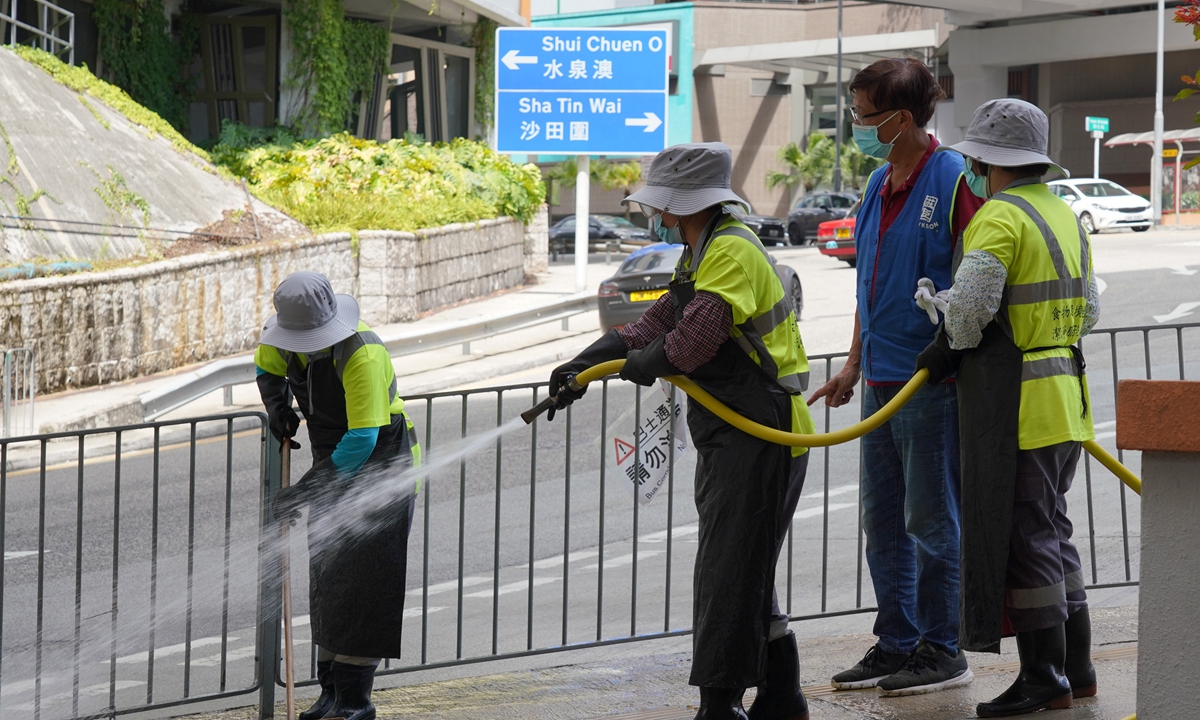HK residents surge into Shenzhen to avoid widening COVID-19 epidemic
By Liu Caiyu Source: Global Times Published: 2020/7/14 22:13:40

Cleaners spray disinfectant fluid to clean the street at Sha Tin, Hong Kong on Saturday. A spike in cases indicates the city has been hit by a third wave of COVID-19. On Sunday, Hong Kong reported 38 newly confirmed cases. Photo: cnsphoto
Ports in Shenzhen, South China's Guangdong Province that are adjacent to the Hong Kong Special Administrative Region (HKSAR) have seen a spike of travelers from the city as many Hong Kong residents have chosento enter the Chinese mainland to avoid new COVID-19 outbreak.
The trend sparked worries about whether the worsening epidemic in Hong Kong would flare up in Shenzhen and break the record set by the mainland city, which had zero new infections for 149 days as of Tuesday.
Passenger flows from Hong Kong to the mainland have doubled in recent days, mostly through the Shenzhen Bay Checkpoint, where long lines of people were seen waiting last weekend in videos circulating online.
The number reached the highest this month on Monday - 2,326, data compiled by the Hong Kong Immigration Department showed. The number on July 1 was only 496.
Residents in the mainland, including those in Shenzhen, have voiced concern online, stressing the necessity for residents from Hong Kong to follow the anti-epidemic rules of the mainland, which have brought the country to a relative safe place, while the pandemic continues in other areas.
Shenzhen will feel pressure with daily entrants reaching about 2,000. It must make sure that those people do not reverse gains against the epidemic that the city has made, Wang Peiyu, a deputy head of Peking University's School of Public Health, told the Global Times.
"It would not surprise me to see Shenzhen reporting imported infection cases in future days as the flow of residents from Hong Kong continues," Wang said.
But Shenzhen, a city with strong scientific research capabilities that can rely heavily on the resources offered by the team of Zhong Nanshan, a top Chinese respiratory disease expert based in neighboring Guangzhou, will be able to handle it, Wang believed.
Coming to the mainland doesn't mean passengers from Hong Kong will be exempt from the epidemic prevention and control measures. The Shenzhen government requires all entrants from Hong Kong, Macao and overseas regions to be quarantined for 14 days, and they have to pay the hotel costs themselves.
Shenzhen also has zero asymptomatic patients or close contacts or confirmed patients in hospitals or under medical observation, the Shenzhen Health Commission said on Tuesday. The city as of Tuesday had reported 462 confirmed cases.
A total of 48 new infections were detected in Hong Kong on Tuesday, 40 of them local, raising the city's tally of new infections to 1,570, data from the HKSAR showed.
Hong Kong residents and students reached by the Global Times said as the Chinese mainland has basically controlled the epidemic with stringent measures, they would be safer there. Some have chosen to stay in the HKSAR, believing their coming back may pose risks to mainland cities or increase their chance of being infected.
"My family and I thought about going back to the mainland where the epidemic is under control, but we eventually abandoned the idea. We might get infected during the trip," Qishan, a middle school student from Hong Kong's Tuen Mun District, told the Global Times.
Many of those coming to Shenzhen are students and their families, who usually return to the mainland for summer holidays. That's another reason why the entry number over the weekend increased, Kevin Choy, a Hong Kong resident, told the Global Times.
Apart from exams, all schools in the HKSAR are expected to suspend on-campus activities from Wednesday for two weeks, the HKSAR Education Bureau said on Tuesday.
To address the "severe" epidemic in Hong Kong, Chief Executive Carrie Lam on Monday announced the city would adopt the most drastic social-distancing rules and require people to wear masks in public.
The new wave of infections in Hong Kong is extending to more communities. Victor Chan Chi-ho, vice chairman of the Hong Kong Association of Young Commentators, told the Global Times on Tuesday that the HKSAR should seek assistance from the central government, consider giving nucleic acid tests to all its citizens, and track asymptomatic carriers.
Chan also said that Hong Kong should adopt centralized quarantine policies like mainland cities do.
The HKSAR will give free nucleic acid tests to high-risk groups, including employees at nursing homes, people who work in the catering sector and property management, and taxi drivers, with the help of two institutes from the mainland.
Given the severe epidemic in Hong Kong, the city was left out of an upcoming program that will exempt people entering Guangdong from the Macao SAR from a 14-day quarantine.
Starting from Wednesday, Guangdong will lift the quarantine for Macao arrivals but they will have to undergo a nucleic acid test and have normal health QR codes upon arrival. They can travel within nine Greater Bay Area (GBA) cities, according to the Zhuhai government.
Liang Haiming, a Hong Kong-based economist and chairman of the China Silk Road iValley Research Institute, told the Global Times that "this is the result of striking a balance between economic activity and epidemic control."
"The public within the GBA has a very high level of linkage in terms of their lives and work. It would take some time before Hong Kong will be included," Liang added.
RELATED ARTICLES:
Posted in: HK/MACAO/TAIWAN,CHINA FOCUS